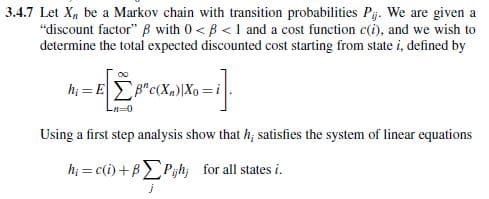3.4.7 Let X, be a Markov chain with transition probabilities P. We are given a "discount factor" ẞ with 0<ẞ<1 and a cost function c(i), and we wish to determine the total expected discounted cost starting from state i, defined by [xxx] ΕΣ Using a first step analysis show that h; satisfies the system of linear equations h=c(i)+BPh for all states i.
3.4.7 Let X, be a Markov chain with transition probabilities P. We are given a "discount factor" ẞ with 0<ẞ<1 and a cost function c(i), and we wish to determine the total expected discounted cost starting from state i, defined by [xxx] ΕΣ Using a first step analysis show that h; satisfies the system of linear equations h=c(i)+BPh for all states i.
Elementary Linear Algebra (MindTap Course List)
8th Edition
ISBN:9781305658004
Author:Ron Larson
Publisher:Ron Larson
Chapter2: Matrices
Section2.5: Markov Chain
Problem 49E: Consider the Markov chain whose matrix of transition probabilities P is given in Example 7b. Show...
Related questions
Question
Please do the following questions with full working out. Answer is in the image

Transcribed Image Text:3.4.7 Let X be a Markov chain with transition probabilities Pij. We are given a
"discount factor" ẞ with 0< ß<1 and a cost function c(i), and we wish to
determine the total expected discounted cost starting from state i, defined by
Ln=0
Using a first step analysis show that h; satisfies the system of linear equations
h=c(i)+BPh; for all states i.

Transcribed Image Text:3.4.7 W11
= 20; W12 =
25
V₁ = 45.
V1
Expert Solution
This question has been solved!
Explore an expertly crafted, step-by-step solution for a thorough understanding of key concepts.
Step by step
Solved in 3 steps with 15 images

Recommended textbooks for you

Elementary Linear Algebra (MindTap Course List)
Algebra
ISBN:
9781305658004
Author:
Ron Larson
Publisher:
Cengage Learning

Linear Algebra: A Modern Introduction
Algebra
ISBN:
9781285463247
Author:
David Poole
Publisher:
Cengage Learning

Elementary Linear Algebra (MindTap Course List)
Algebra
ISBN:
9781305658004
Author:
Ron Larson
Publisher:
Cengage Learning

Linear Algebra: A Modern Introduction
Algebra
ISBN:
9781285463247
Author:
David Poole
Publisher:
Cengage Learning